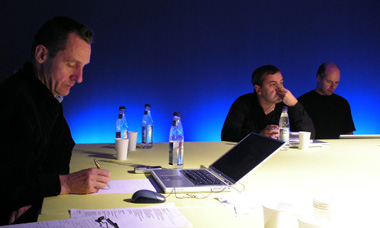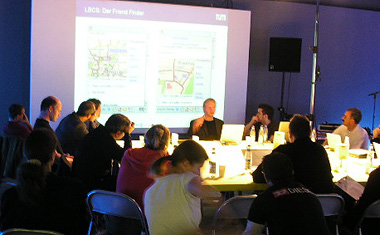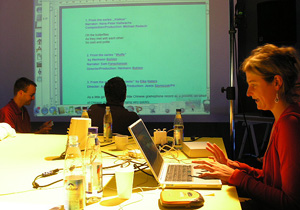Mobile Experience Network
Handheld tools for creative people
International symposium on Mobile Creativityjournal day 2
Symposium
15.-16. June 2005
overview
schedule
participants
venue
written by Tamiko Thiel
thursday, 16. June 2005
work shop
10:00 - 17:00
Q.: What do people want to focus on today?
Jorn Ebner
• spatial activity is always in relation to environment - walking from point A to point B is a spatial activity
• Do we really understand mobility? Nomads, Gypsies, homeless people actually LIVE mobility. When „we“ talk about mobility, we assume a fixed base and define mobility in relation to that.
• The BODY is the most immediate mobile device. Is a mobile phone really necessary for mobile experience?
Steffen Walz
• too much gear makes you IMMOBILE
• I’m interested in FUN!!! Kids have fun when they play, move ... there is a deep connection between the moving body and fun
KP Ludwig John
• what’s the learning curve? Will we have to relearn the technology constantly?
• are complex systems the way to go? maybe lots of small objects is a better way to go.
• need to consider cost, security, learning curve
Jürgen Sieck
• tech problems are always the same: positioning, reading, big gear ... we always say it’ll get better in the future
• there was no talk yesterday about REVOLUTION - are there other ideas, other tools out there?
Russel Beal
• why are so many artists interested in involvement with mobile tech
• but are artists also DRIVING the technology?
• how well do we understand this future and what it’ll be like?
• what is a suitable metaphor for mobile interfaces, for instance like the desktop was for a PC?
• we need to look at mobility of data as well as mobility of users
Rainer Malaka
• how many projects yesterday were showcases? how many were real products? hard to understand which was which.
• what is the impact of a project? Is it inspiration, a device, a real product?
• why do I NEED this?
• context is important, but how about language?
• how can system understand what user wants?
• found KP’s analogy of the change in Golden Nica from man-machine focus to person-person focus
Jürgen v. Stenglin
• felt that Horst Hörtner/Ars Electronica spoke about poetry but the works didn’t support or provide poetry
• poetry bridges the gap between the real and the idea, presents a challenge, asks a question
Patrick Robertson
• Why do people try new things? Do they NEED them? Do they WANT them?
• In the future will I feel naked if I DON“T have my mobile with me, DON“T wear my AR glasses? What if I go to Heidelberg without my AR glasses? Will I feel I’m missing the most important part?
• Walkman and Ipod fulfill essentially the same function, are used by same % of the population. Technology has changed but usage hasn’t.
• What will make a new revolution, what will you USE differently?
• „mobility“ will become a non-term, the difference between mobile and immobile will disappear.
Recapitulation of what has been said so far
Thomas Rist: important concepts
• deepness on concept, ranging from flat <-> sustainable
• time scale: concept -> showcase -> prototype -> (mass) product
• human-centered design approach: scenario-based development, metaphors need to be developed for the field, more feedback
• NOT discussed: social implications, our role in the process
Horst Konietzny
• how stressful is it/will it be to be mobile - always available, always online? What are the consequences for us? How can we make it fun?
• can artists be incubators? are they taken seriously by the industry?
Case study:
„Pilot Mobile Community Service COSMOS Lifestyle Project“
Oliver Brakel, Sociologist at the TU Munich
Question was, „what CAN we make mobile?“
• wanted to support and expand an existing virtual community
• chose jetzt.de („jetzt“ = „now“).
[ jetzt.de started as youth magazine of the Sueddeutsche Zeitung (very high quality Munich daily newspaper), now is a youth section in the paper once a week plus a website. - tt]
• General jetzt.de community:
o more women than men
o university education
o working in „creative“ professions.
o Quality of writing in jetzt.de publications is high
• existing website community services:
o community members could write texts, commentaries for the website
o instant messaging
o whois online
• 75 current jetzt.de users chosen for pilot project, aged 16 - 35
• users given PDA w/pilot mobile services, asked to just use it however they wanted
• O2 supplied network hardware and end user device Xda (PDA + telephone)
o Xda had large display, which was good, but proved to be difficult to use
Functionality:
• guest book from jetzt.de website, messaging (O2 services)
• pilot service: Friend Finder - where are the others?
o user position determined, sent to server with +/- 150 meter accuracy
o positioning tech wasn’t always very stable and erroneous results could cause serious social problems - „Why have user X and user Y been together in the same position for the entire weekend?“
• pilot service: Friend Alert - you get a message when a friend is near you
o position wasn’t accurate enough: you might get a message but the others were in a completely different biergarten.
• but as pilot, provided enough experience that users could get an idea of how they would use such services, and could therefore give feedback on whether they would want to have it, be willing to pay for it.
Conclusions:
• extending web services to mobiles would be popular
• location based services problematic
o technology not good enough (position)
o would people want to use it? yes, if you could choose whether or not it is turned on - sometimes you don’t WANT everybody to know where you are
• community services often used to kill time while waiting, traveling
• would they be willing to pay? theoretically, yes [how much? - tt]
Requirements for implementation:
• implement for communication-centered communities
• services would also work on normal consumer mobile devices
• login must be simplified:
o people wanted to use same logins as for website, but complicated login names are difficult to type in on mobile phones (special characters, numbers, etc.)
o although mobile phone automatically logged into server, data protection prevents automatic login with same device code to services.
Q & A:
• Q/[man]: Studies show women tend not to want their positions to be broadcast, was that true in this study?
• A: Women didn’t mention this of their own accord as a concern. If however they were asked about it, they had problems with it. There seems to be a difference between „what I use, what I do“ on the one hand and „what I think about it“ on the other hand.
• Q/KP Ludwig John: does O2 want to implement the services?
• A: Impression of O2: sees itself as infrastructure provider, not content or services provider. The question is rather whether jetzt.de wants to continue the services, whereby the financial questions (how much would it cost, how would services be billed) are very important and not yet clear.
• Q/Steffen Walz:
o What did users have to pay?
o Did people who didn’t know each other beforehand communicate through these services? That is, did the services extend the community?
o Were the positioning services really used? How?
• A: See some of previous answers ... the heaviest user turned out to be using his cell phone to listen to internet radio, which he discovered he could access through the community services.Case Study: „Further development of a mobile exhibition tour guide“
Georg Schneider
Questions posed by the case study: What can you do, what do you want to do? What is really used?
• For instance success of SMS was a surprise - HCI field would’ve never predicted it
Case study focused on Landesgartenschau Trier (State Garden Exhibit in Trier)
• End user device was PDA with localisation, map, info on exhibit and available services
• Usage was free, nothing was stolen, usage spiked of course on weekend
Results of questionaire:
• Sample size ~400 people
• Medien age 37 years, range mostly 21 - 50 years
• Most users used PDA for 1.5 - 4.5 hours, mean was 3.5 hours
• Was it fun? 70% yes
• Helpful? 80% yes (better than printed info, not as good as human tour guide)
• Readability/visibility of display out of doors? 55% OK, 18% very good
• Size of display? 75% OK
Ideas for further development:
• sound, music, 3D sound, AR
• integration of user
o personalized routes („this group suggested this route“)
o location based communication: users can leave notes in locations (personal impressions of the rose garden, etc.)
• further usage of info:
o integrating existing info from other sources
o continuing to use info after Landesgartenschau is over

Manfred Tscheligi
• area of interest is context data as reported yesterday by Kristijan Mihalic
• context modeling usally not the same as user’s perspective & idea of context
• identifying landmards to be used in navigation systems
o system should use voice guidance and references to existing landmarks
o Q: how/what do people PERCEIVE as landmarks?
• Meaning of usability? Is this the same as fun? How to measure this WHILE people are using?
• „multichannel“ experience - not just using mobiles, also web, etc. - how to design services using ALL possible channels?
KP Ludwig John: Landesgartenschau as situation offers other „channels“: smell, weather, etc.
Steffen Walz:
• Do we really need augmentation such as in Landesgartenschau Trier? Sometimes you just want to smell the flowers ...
• Needs to be part of the basic concept from the beginning of the planning, otherwise it is just an add-on and irritating.
Tamiko Thiel
• You need to have choice whether or not you use the material
o e.g. non-linear structure, so you can skip over content that doesn’t interest you
• But even a flower (and pretty much EVERY flower!) has an enormous amount of cultural context behind it:
o symbolism (different in every culture)
o literature, poetry
o scientific info
o care and feeding
o sharing responses - e.g. sending or leaving haiku for someone, triggered by this flower, this garden etc.
• why shouldn’t you be able to access this info on location if you want to? Some users will, some won’t - they should have the choice
Patrick Robertson:
maybe what’s needed is „volume control:“ easy set of icons to call up
• different augmentations of the experiences
• different contexts (music, historical, scientific etc.)
Sonja Bachmeier, student
• Art is often or even usually contextualized (in museum, galleries, biennales, etc.) You go somewhere to look at art.
• With mobile technology, art could be anywhere.
• In what spaces is art „allowed“ with mobile tech? How does the user know to contextualize something as art?
Horst Konietzny:
• YOU [the user? the artist? - tt] define the frame, YOU define this to be the art experience.
• mobile tech also allows experience to be shared
Rainer Malaka:
• But do people WANT to share? Do they WANT to hear more? With WHOM do they want to share?
Steffen Waltz:
• What is FUN? What is fun in mobile computing?
• Is there a stimulus that makes something fun?
Example:
Natalie Singer / Deutschlandradio Wurfsendung
• Content: kleine Haiku, micro-radioplays, etc.
• Inserted in radio programs - 3 very short items per block, like advertising (quick and dirty, so to speak, quick enough so no one is upset at „wasting time“)
• mobile distribution/broadcast possibilities:
o „hey, let’s go to ZKMax and see what jokes the xPOSTEN is sending“
o waiting areas: bus stops, elevators, bathrooms, etc. - are these interesting places for broadcasting this sort of content? Like the video screens on the Munich subway platforms.
o Or is this just irritating?
Steffen Walz:
• Audio likes to be alone - easily disturbed by other sounds.
• If you miss 15 seconds of a radio play you lose the thread.
Summary of workshop: What have we come up with?
Patrick Robertson:
better categories than „mobile services:“
• universal remote control device
• mobile experience, etc.
Thomas Rist:
We should strive for feature GROUPING rather than feature COMPLETENESS, because we’ll never get completeness
Jorn Ebner:
The device should be seen as an activator rather than a machine.
Rainer Malaka: importance of context - not just external but also user’s internal/personal.
Russell Beal: cultural/historical context versus physical/situational context
Christian Hauck:
• most interesting uses for him were the “useless” “senseless” such as the Wurfsendung
• “useful” tasks were more boring
Horst Konietzny:
• How could the workshop concept be extended, could continue after and outside of this meeting?
• Is there a way to bring artists and technologists together?
Rainer Malaka:
Smart Graphics Symposium tries to do this, and is in Munich this year
Georg Schneider:
The exact point in time a feature is implemented is very important for its acceptance. Too early or too late can kill a good idea.
Nathalie Singer: You have to ask, “Is it the right time? Would it be seen as hip and cool?”
Jorn Ebner:
European projects could integrate artists as part of the team and art as part of the methodology, not just technology and science.
Steffen Waltz:
Network services providers think „art“ means „no one will understand it“ and are therefore afraid to integrate it into their programs.


